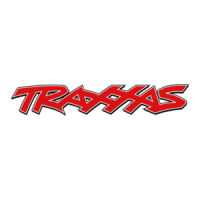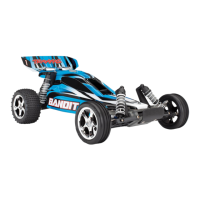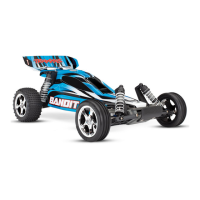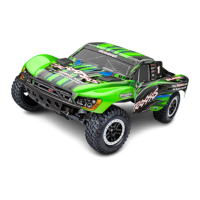Do you have a question about the Traxxas Bigfoot and is the answer not in the manual?
Information on customer support options and contact methods for Traxxas products.
Guide to getting the model up and running quickly, outlining essential procedures.
Instructions for product registration online for better customer service.
Regulatory compliance information for digital devices according to FCC rules.
Regulatory compliance information for digital devices according to Industry Canada rules.
Statement regarding radio frequency exposure limits for the device.
Identifies icons for warnings, tips, and cross-references throughout the manual.
Contact information and resources for Traxxas technical support and service.
Critical safety guidelines and operational considerations for safe model use.
Precautions for operating the electronic speed control and preventing damage.
Lists the specialty metric tools included with the model.
Lists the equipment that must be purchased separately to operate the model.
Lists optional but recommended tools and supplies for an R/C toolbox.
Introduces the TQ 2.4GHz transmitter and its automatic frequency locking capabilities.
Defines key terms related to the radio system and power components used in the manual.
Identifies the components of the TQ 2.4GHz radio system and their labels.
Explains the meaning of different LED light patterns on the battery charger.
Guidance on selecting and using appropriate batteries for the transmitter.
How to adjust the steering trim for proper neutral steering alignment.
Procedure for reversing steering or throttle servo direction if needed.
Procedure to test the radio system's range and ensure proper operation.
Technical specifications for the XL-5 electronic speed control.
Explanation and settings for Low-Voltage Detection on the XL-5 ESC.
Step-by-step guide to program and calibrate the XL-5 ESC and transmitter.
Describes the different operating profiles available for the XL-5 speed control.
Instructions for selecting and activating Sport Mode (Profile #1) on the XL-5.
Instructions for selecting and activating Race Mode (Profile #2) on the XL-5.
Instructions for selecting and activating Training Mode (Profile #3) on the XL-5.
Quick guide for changing between Sport and Training modes on the XL-5.
Discusses factors affecting battery run time and theoretical comparisons.
Provides advice on how to maximize the model's running time.
Explains how battery capacity (mAh) affects top speed and power output.
General safety and operational precautions for running the model in wet conditions.
Steps to take before operating the model in wet environments.
Specific precautions for the Titan motor when exposed to wet conditions.
Procedures for cleaning and maintaining the model after wet operation.
Instructions for safely removing the receiver from its watertight box.
Steps for correctly installing the receiver back into the watertight box.
How to adjust the slipper clutch for optimal power transfer and tire spin control.
Guidance on setting toe-in for improved steering and stability.
Advice on adjusting shocks and springs for optimal handling and ride height.
Information on choosing and using different wheels and tires for performance.
A chart showing various gear ratio combinations and their compatibility.
Details on inspecting and replacing slipper clutch pads based on wear.
Guidance on cleaning and inspecting the chassis for damage.
Maintenance for steering system components like servo saver and tie rod ends.
Procedures for cleaning and lubricating the motor periodically.
Maintenance advice for shock absorbers, including oil levels and rebuilds.
Inspecting suspension components for damage or wear.
Inspecting the driveline for wear, including yokes, shafts, and gears.
Instructions for storing the model properly, including battery removal.
| Scale | 1:10 |
|---|---|
| Drive type | 2-wheel drive (2WD) |
| Engine type | Electric engine |
| Product type | Monster truck |
| Housing color | Multi |
| Maximum speed | 48.2803 km/h |
| Chassis material | Nylon |
| Housing material | - |
| Channels quantity | 2 channels |
| Construction type | Ready-to-Run (RTR) |
| Bearing technology | Ball bearing |
| Protection features | Water resistant |
| Transmitter frequency | 2.4 GHz |
| Moving control functions | Backward, Forward, Turn left, Turn right |
| Electronic speed control (ESC) | Yes |
| Battery technology | Nickel-Metal Hydride (NiMH) |
| Number of battery cells | 7 |
| Compatible battery sizes | AA |
| Number of batteries (transmitter) | 4 |
| Width | 324 mm |
|---|---|
| Height | 241 mm |
| Length | 413 mm |
| Weight | 1850 g |
| Wheelbase | 270 mm |
| Tire width (front) | 55.88 mm |











